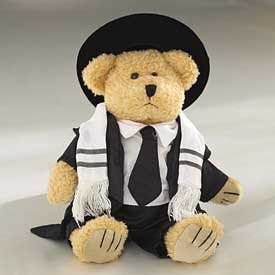Guest Posting By Rabbi Dovid Sears - Jewish Nationalism And Post-Nationalism

In Loving Memory of My Mother, Gittel bas Yitzchok / Grace Sears, a”h, On Her First Yahrtzeit, 5 Adar 5769/Sunday, March 1, 2009
Jewish Nationalism and Post-Nationalism
What is Jewish nationalism? Why isn’t it enough for Judaism to exist as a religion? Why must this religion be translated into a coherent and living society? What is meant to be unique about that society? What is its role in relation to the rest of the world?
Once upon a time, Jewish nationalism wasn’t a novelty, a subject of philosophical discussion and debate: “Are the Jews members of a nation or a religion? Should the State of Israel have been created or not? Will the existence of Israel solve the problem of anti-Semitism?” And so forth. The Jewish people lived in Eretz Yisrael and tilled the soil, harvested their trees and crops, built homes and citadels, decorated their places of worship with colorful mosaics, played musical instruments, wrote great religious texts and poetry, studied the Torah according to a rigorous system of hermeneutics, minted their own coins, spoke one common language, and defended their land when conquering enemies approached.
After Rome razed and burned Jerusalem and sent the populace into exile two thousand years ago, another kind of Jewish nationalism emerged: kehillah life, so familiar to traditional Jews, as originally conceived and implemented by the Talmudic sages. The kehillah became a religious and social “binding agent” for a homeless nation scattered to the four winds. This formula, gently helped along with the ghettoes of Europe and the dhimmi laws of the Islamic Middle East, enabled the Jewish people to survive the turbulent seas of our long exile until the present. But with the advent of the Enlightenment and the rise of modern democracies, the ghetto walls came tumbling down, and Jewish life changed forever. Participation in the kehillah soon ceased to be the common Jew’s only option (apart from conversion, a choice for which relatively few opted). Increasing numbers attempted to assimilate, to one degree or another, and leave behind the sorrows of exclusion, persecution, and poverty. For as long as anyone remembered, the Jews had lived a carefully restricted, spiritually rich but culturally and even psychologically truncated existence – both as individuals and a society. In most times and places, a Jew could not join the craftsmen’s guilds, enter the professions, or even own land. Torah was not only the “best merchandise,” it was just about the only merchandise, aside from actual commerce, a few simple trades, and tenant farming. While it is indisputable that the Torah is our life, not everyone is cut out to be a scholar. The ghetto life greatly limited the creative capacities of the individual and the people. Then suddenly a host of new possibilities appeared on the horizon. Attractive possibilities.
Most rabbinic leaders were dismayed by the threat modern life presented to traditional Jewish life and religion. Democracy was a Pandora ’s Box that an inherently conservative leadership would have preferred to leave unopened. However, Rav Samson Raphael Hirsch of Frankfurt, Germany, whose contemporaries were at the vanguard of assimilation, was not such a reactionary. The Rav of Frankfurt took a surprisingly positive view of the new age and the many opportunities it offered for Jewish participation in society. By leaving the ghetto and entering the world arena, the Jewish people might bring about a far greater kiddush Hashem than ever before was imaginable. In his Commentary on the Torah, Rav Hirsch wrote:
God said unto [Jacob]: “I am God, the All-Sufficing. Be fruitful and multiply; a nation and a community of nations shall come into existence from you” (Genesis 35:11).
Commentary: The nation that descends from him is to represent one entity to the outside world, but internally it is a multiplicity of elements forged into one. Each tribe is to represent an ethnic individuality in its own right. The nation of Jacob, which as “Israel” demonstrates to the other nations the power of God triumphantly pervading and shaping all of mankind, must not present a one-sided image. As a model nation, it should reflect the greatest range of national characteristics in microcosm. In its tribes, it should variously represent the warrior nation, the merchant nation, the agricultural nation, the scholarly nation, etc. Thus, it will become clear to all the world that the consecration of human life to the Law of God does not demand occupational restrictions, or depend upon specific ethnic characteristics, but that mankind in all its diversity is capable of accepting the monotheism taught by Israel, and of fashioning the multiplicity of human and national individualities into one united kingdom of God.
These words have an unmistakably idealistic ring. They suggest that the time has come for a broader understanding of the Psalmist’s declaration, “Know Him in all your ways!” Not only must we do so through the study of Torah and performance of mitzvos, as central as these practices are to Judaism, but through the development of all our God-given abilities and by contributing to society at large in the fullest possible way.
Still more radical things were in store. A generation later, the utopian vision of Rav Avraham Yitzchak Kook far surpassed that of Rav Hirsch. The Lithuanian-born halachist, philosopher, and mystic saw the hidden hand of God in the fledgling Zionist movement of the late 1800s-early 1900s – a movement that for the most part was running like an express train in the opposite direction from God and religious faith. To Rav Kook’s thinking, the return of the Jewish people to our ancestral homeland was much more than Theodor Herzl’s dream of a “safe refuge” for an unwanted and persecuted minority. It was a giant step toward the fulfillment of our collective destiny to become a nation like none other: a universal nation, whose raison d’etre would be to benefit all of humanity. The Jewish people would no longer remain fugitives of history, an entity unto themselves, as in the Middle Ages, nor would they content themselves merely to contribute to the broader societies in which they lived, according to the Hirschian model. They would become at last that “light unto the nations” of which the prophets foretold, the divinely-appointed channel for the enlightenment of the world.
Rav Kook voices this idea in his seminal essay, “Fragments of Light: A View as to the Reason for the Commandments,” where he speaks of nationalism as a prelude to a broader trans-nationalism, or “humanity consciousness”:
The very fact that national consciousness emerges before humanity consciousness, and the latter before cosmic consciousness, causes the vitalization of particular nations to precede the organic vitalization of humanity, of which the prophets spoke. The latter must necessarily precede the vitalization of the constituent entities, which embraces everything, reaching down to include the vitalization of every individual, in all his splendor and glory, with which are associated reason and imagination, instinct and nature. The community of Israel does not grow weary in traveling this eternal, long road. She “treads on the high places of the earth,” ever aspiring toward an “unbounded inheritance” (Shabbos 118a) in which she will stand in one fellowship with “all His works and all His creatures” (liturgy). All the awesome spreading out of this aspiration does not blur the practical aspect of her national essence . . . On the contrary, it endows it with greater force and clarity at the same time, for the full synthesis of all the life-forces in their collectivity is stored within her treasure trove. It is the “light of the universe in the treasure of life.”
Here we see that in Rav Kook’s view, there is no contradiction between the national aspect of Israel and the universal light that it bears within its very being. He goes on to state that this is a nationalism fundamentally unlike all other nationalisms, both ontologically and in its historical mission. The key to this is the spiritual element that lies at its core:
The moral life cannot evolve to its highest development except through the influence of its divine source. The divine source will have its practical effect of preparing the way for a social culture only through a societal perfection that is first established in a stable and highly-cultivated nation that is prepared to exist as a unique people. Its uniqueness is not enclosed in its particular nationality, which can stand competition with other nationalisms whose only purpose is confined in their own nationhood or in the social conditions they precipitate. The national content of this people [i.e., Israel]can absorb what is glorious in all nations, the best of the idealism of fragmented humanity, and spread it later, in a more perfect and developed state, and in an appropriate and permanent form under the stamp of its own bold and luminous authenticity . . . The renewal of the Jewish people in its thrust toward the future is directed with all its resources in a veritable opposite direction from that of the exodus from Egypt. It moves toward unification with all humanity…
One wonders what Rav Kook would say about the State of Israel today, with chilonim (secular) and dati’im (religious) perpetually at each other’s throats; whose political leaders, one after the next, seem to be caught with one hand in the till while the other waves the white flag of post-Zionism; surrounded by the “seventy wolves” baring their poisonous fangs from the United Nations (if ever the name of an organization was more oxymoronic); her ears ringing with political tinnitus over the intolerable fact of her existence.
Where is that elusive light of wisdom Israel is meant to bear, which will banish the darkness of greed, aggression, and blind passion? What happened to the spiritual vision that defined the very nature and purpose of our people throughout history? Would Rav Kook be able to find the still-smoldering embers of our hidden vitality in these thick ashes?
It seems that Rav Kook foresaw all of this, too. We may take hope from another of his essays, “The Soul of Nationhood and Its Body”:
In a gloomy spirit, full of anger and sadness, [the nation] will pride itself in the outwardness of a language whose mighty holiness it does not recognize, of a land from whose wondrous qualities it is alienated, of nostalgic yearnings from which it has discarded every element that can nourish and vitalize. The nobler and more spiritual a nationalism is at its source, the more the adherents of this debased nationalism will despise it...
This is the narrow state to which the community of Israel will descend prior to an awakening of the true revival. Then, upon awakening, she will cast aside with indignation all of her dross, and with divine resolve she will gather to herself all her good…
From the source of higher delight will flow many spices to remove the foul smell that had been absorbed by a crude nationalism trapped in its materialism. And as smoke fades away, so will fade away all the destructive winds that have ravaged the land, the language, the history, and the literature. “I will give you a new heart, and I will place in you a new spirit; and I will remove the heart of stone from your body and give you a heart of flesh. I will put My spirit within you, and I will cause you to walk in My statutes, and you will heed My laws and perform them. And you will dwell in the land I gave to your ancestors, and you will be my people, and I will be your God” (Ezekiel 36).


















.gif)












